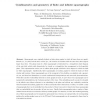10 search results - page 2 / 2 » Game coloring the Cartesian product of graphs |
DM
2010
13 years 4 months ago
2010
A labeling of a graph G is distinguishing if it is only preserved by the trivial automorphism of G. The distinguishing chromatic number of G is the smallest integer k such that G ...
EJC
2008
13 years 4 months ago
2008
The distinguishing number D(G) of a graph G is the least integer d such that G has a labeling with d labels that is preserved only by a trivial automorphism. We prove that Cartesi...
CORR
2010
Springer
13 years 4 months ago
2010
Springer
The oriented chromatic number of an oriented graph G is the minimum order of an oriented graph H such that G admits a homomorphism to H. The oriented chromatic number of an undire...
SIAMDM
2008
13 years 4 months ago
2008
The first-fit chromatic number of a graph is the number of colors needed in the worst case of a greedy coloring. It is also called the Grundy number, which is defined to be the max...
SIAMDM
2010
12 years 11 months ago
2010
Abstract. Squaregraphs were originally defined as finite plane graphs in which all inner faces are quadrilaterals (i.e., 4-cycles) and all inner vertices (i.e., the vertices not in...

